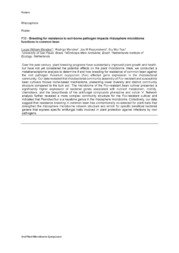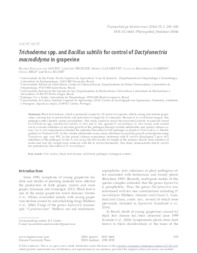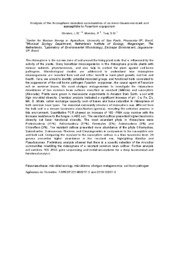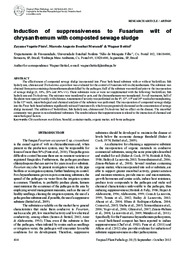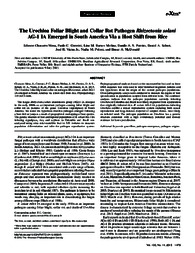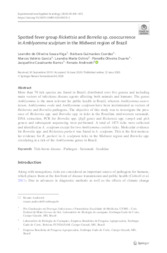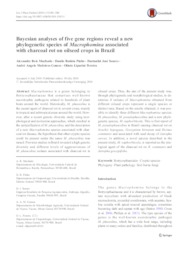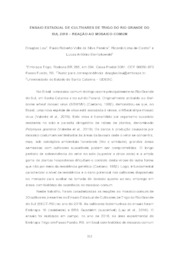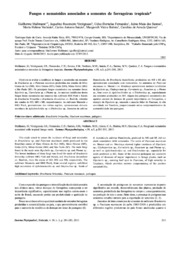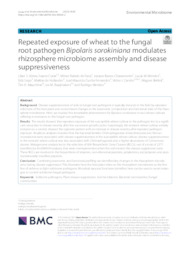Busca de Publicações
Filtrar por:
| Autoria: MENDES, L. W.; MENDES, R.; RAAIJMAKERS, J. M.; TSAI, S. M. Over the past century, plant breeding programs have substantially improved plant growth and health, but have not yet considered the potential effects on the plant microbiome. Here, we conducted a meta... ... |
| Autoria: SANTOS. R. F. dos; HECKLER, L. I.; LAZAROTTO, M.; GARRIDO, L. da R.; REGO, C.; BLUME, E. Black foot disease, which is primarily caused by Dactylonectria species, affects young and mature grapevines, causing loss of productivity and reduction of longevity of vineyards. Because it is a soil... ... |
| Autoria: MENDES, L. W.; MENDES, R.; TSAI, S. M. The rhizosphere is the narrow zone of soil around the living plant roots that is influenced by the activity of the plants. Many beneficial microorganisms in the rhizosphere provide plants with mineral... ... |
| Autoria: PINTO, Z. V.; MORANDI, M. A. B.; BETTIOL, W. Abstract: The effectiveness of composted sewage sludge incorporated into Pinus bark-based substrate with or without biofertilizer, fish hydrolyzate, chitosan and Trichoderma asperellum was evaluated f... ... |
| Autoria: MESA, E. C.; CERESINI, P. C.; MOLINA, L. M. R.; PEREIRA, D. A. S.; SCHURT, D. A.; VIEIRA JUNIOR, J. R.; POLONI, N. M.; MCDONALD, B. A. The fungus Rhizoctonia solani anastomosis group (AG)-1 IA emerged in the early 1990s as an important pathogen causing foliar blight and collar rot on pastures of the genus Urochloa (signalgrass) in So... ... |
| Autoria: HIGA, L. de O. S.; CSORDAS, B. G.; GARCIA, M. V.; OSHIRO, L. M.; DUARTE, P. O.; BARROS, J. C.; ANDREOTTI, R. More than 70 tick species are found in Brazil, distributed over five genera and including main vectors of infectious disease agents affecting both animals and humans. The genus Amblyomma is the most r... ... |
| Autoria: MACHADO, A. R.; PINHO, D. B.; SOARES, D. J.; GOMES, A. A. M.; PEREIRA, O. L. Macrophomina is a genus belonging to Botryosphaeriaceae that comprises well-known necrotrophic pathogens related to hundreds of plant hosts around the world. Historically, M. phaseolina is the causal... ... |
| Autoria: LAU, D.; PEREIRA, P. R. V. da S.; CASTRO, R. L. de; STEMPKOWSKI, L. A. No Brasil, o mosaico-comum do trigo ocorre principalmente no Rio Grande do Sul, em Santa Catarina e no sul do Paraná. Originalmente atribuído ao Soil-borne wheat mosaic virus (SBWMV) (Caetano, 1982),... ... |
| Autoria: MALLMANN, G.; VERZIGNASSI, J. R.; FERNANDES, C. D.; SANTOS, J. M. dos; VECHIATO, M. H.; INÁCIO, C. A.; BATISTA, M. V.; QUEIROZ, C. de A.
|
| Autoria: COSTA, L. S. A. S.; FARIA, M. R. de; CHIARAMONTE, J. B.; MENDES, L. W.; SEPO, E.; HOLLANDER, M. de; FERNANDES, J. M. C.; CARRIÓN, V. J.; BETTIOL, W.; MAUCHLINE, T. H.; RAAIJMAKERS, J. M.; MENDES, R. Abstract: Background -Disease suppressiveness of soils to fungal root pathogens is typically induced in the field by repeated infections of the host plant and concomitant changes in the taxonomic comp... ... |
Observações
1 - Por padrão são exibidas publicações dos últimos 20 anos. Para encontrar publicações mais antigas, configure o filtro ano de publicação, colocando o ano a partir do qual você deseja encontrar publicações. O filtro está na coluna da esquerda na busca acima.
2 - Para ler algumas publicações da Embrapa (apenas as que estão em formato ePub), é necessário ter, no celular ou computador, um desses softwares gratuitos. Sistemas Android: Google Play Livros; IOS: iBooks; Windows e Linux: software Calibre.
Acesse outras publicações
Acesse a Base de Dados da Pesquisa Agropecuária (BDPA) para consultar o acervo completo das bibliotecas da Embrapa.

